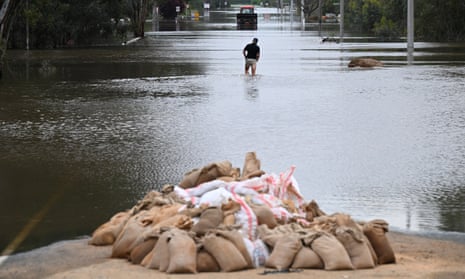Climate change is rendering terms like “one-in-100-year” flood useless and flood maps across Australia need to be uniformly updated immediately so communities and agencies can better mitigate disasters, experts say.
The call to standardise flood mapping comes during flood crises in New South Wales and Victoria, and concerns over continued development on flood plains due to old maps.
Flood maps are created using historical weather records, tide data and digital mapping technologies to assess the risks of an area, including how rivers cope with rising levels and how water runs over the land.
Councils commission private companies to create the maps, which include predicted flood level markings that inform planning regulations.
But the chief executive of Climate Valuation, flood mapping expert Dr Karl Mallon, said different inputs and guidelines were being used across the country, creating a “massive amount of inconsistency and dysfunction”.
He said state governments needed to provide clear guidelines to councils about what needs to be included in maps, when they are updated and the impacts of a changing climate.
“It’s at a state level where the rubber hits the road,” he said. “We’ve got to have apples and apples [in] how is flood mapping done. You want things to be as consistent as possible. You want very clear guidance on the extent to which climate change is included.”
Flood maps are used to work out the “one-in-100-year” flood level lines that are used to inform the planning and insuring areas.
“A one-in-100-year event, historically, now needs to be replaced with a frequency which is higher. When [water] comes down, it’s still going to go to the same places but what comes down, there will be more of it,” Mallon said.
The most recent river flooding map available on the Lismore council website was from 2010 and the region’s risk management plan is from 2014. In nearby Ballina, the flood map was last updated in 2008 and the management plan in 2015.
Similarly in Victorian areas that have been inundated in recent weeks, the Benalla flood plan on the State Emergency Service website was updated in 2014, while the Moira region’s was done in 2020.
Former Fire and Rescue NSW commissioner and founder of Emergency Leaders for Climate Action, Greg Mullins, wanted all maps to be updated because of the speed of change.
He said terms like “one in 100” were “pretty well useless these days”.
“We’re getting out-of-scale events driven by climate change so it’s vital that we have up-to-date risk analysis and modelling,” he said.
The report of an independent inquiry into flood management, which examined flooding across NSW in February and March, recommended an end to building on floodplains. Mullins said accurate data was needed for such a move.
after newsletter promotion
“To stop any more homes being built on identified floodplains, you must have up-to-date data … because it’s changed. It’s worse and there’s more areas at risk than there used to be,” Mullins said.
“It’s vital that all levels of government have up-to-date information and the same information, so it’s shared.”
Earlier in the year, the Planning Institute of Australia called for statewide consistency in flood mapping.
Its Victorian division president, Gabby McMillan, said current mapping was “patchy and outdated” and did “not reflect the dynamic nature of flood risk under climate change”.
In NSW, councils are required to provide flood mapping information to the public under the guidance of a Department of Planning and Environment floodplain development manual.
It recommends councils review their flood management plans every five years or after a significant event, such as recent flooding.
In Victoria, if a proposed development is in a flood zone, a planning permit is required and a referral to a floodplain management authority is triggered.
The Victorian government said councils were able to update their maps in consultation with the relevant water authority.
“[They] who can provide guidance around water patterns specific to their area to make sure their planning controls are up-to-date,” a government spokesperson said.
